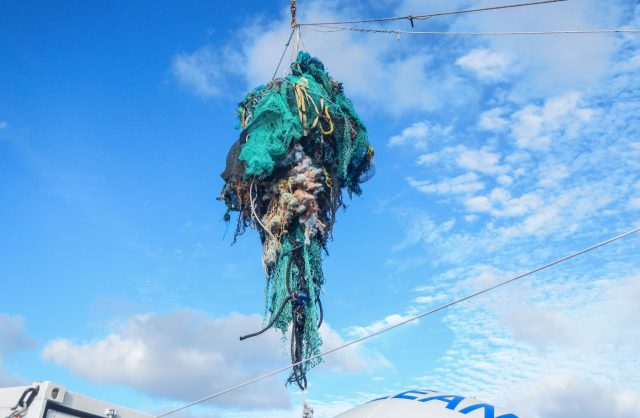
Announcing the Aerial Expedition
Back to updatesWe are proud to announce The Ocean Cleanup’s next major research mission: the Aerial Expedition. In September and October 2016, we will conduct a series of low-speed, low-altitude flights across the Great Pacific Garbage Patch in a C-130 Hercules aircraft, using expert spotters and state-of-the-art sensors. Our aim is to accurately measure the biggest and most harmful debris in the ocean. It will be the first-ever aerial survey of an ocean garbage patch.
In order to solve the plastic pollution problem, it is essential to understand its dimensions. Knowing how much and what kind of plastic has accumulated in the ocean garbage patches is especially important. This determines the design of cleanup systems, the logistics of hauling plastic back to shore, the methods for recycling plastic, and the costs of the cleanup.
We started finding answers to these important questions when we launched the Mega Expedition a year ago. With a fleet of about 30 vessels, we produced the first high-resolution map of the world’s largest accumulation zone of oceanic plastic: the Great Pacific Garbage Patch, situated halfway between Hawaii and California. We discovered that the conventional method of measuring ocean plastic, using nets of less than a meter (3 ft) wide, was inaccurate because it seriously underestimated the total amount of plastic. The reason for this is simple: the larger the objects, the rarer they are by count.
This is an important statistical concept. Say you drag your small net over an area the size of a football field. You will be able to accurately quantify microplastic, several particles of which you may encounter in every square meter you survey. But if the largest object occurs only once in every five football fields, there is a good chance you will miss that object and miscalculate the total amount of plastic. You need to cover a larger surface area to accurately measure the bigger pieces of debris. With the Mega Expedition, we did so by dragging large nets (measuring 6 m across), accurately quantifying debris of up to half a meter (1.5 ft) in diameter.

But how do you quantify even bigger garbage? We know there are plenty of very large objects like ghost nets – tangled balls of discarded fishing gear several meters wide – floating in the Great Pacific Garbage Patch. These ghost nets are known to be a major hazard to vessels and marine life. This is where the 2016 Aerial Expedition comes in.
While the nets used on the Mega Expedition surveyed a combined 18 km2, the Aerial Expedition will inspect an estimated 6000 km2 – more than 300 times the area. This should allow us to quantify the largest pieces of trash in the ocean and resolve this last piece of our puzzle.
NOAA once conducted a visual survey outside of an accumulation zone, near the Northern Hawaiian Islands. But no one has ever attempted to quantify ghost nets and other ‘mega debris’ within an ocean garbage patch. If we find concentrations within the patch similar to what NOAA observed near Hawaii, this could nearly double our current estimate on the amount of plastic present in the area.

The Ocean Cleanup’s Aerial Expedition will use a combination of experienced human observers and advanced sensors to count the debris. The sensors will also help convert the count to a weight estimate by registering the size of the found objects. The C-130 Hercules aircraft operated by expedition partner International Air Response will give us the long range and reliability we need. The Aerial Expedition’s results will be combined with the data we collected on the Mega Expedition, resulting in a study we expect to publish in early 2017.
Taking off from Moffett Airfield in Mountain View, CA, the aircraft is scheduled to make several flights from September 26th to October 7th. The carbon emissions generated by the aircraft will be offset through clean energy compensation, for which we are generously supported by the South Pole .
Follow the expedition’s progress on The Ocean Cleanup’s Facebook, Twitter feed and Instagram account.


